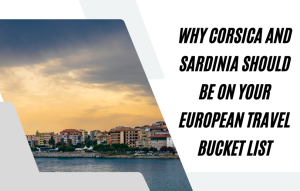Discover the Natural Beauty of Corsica
Majestic Mountains and Serene Coastlines
Corsica is often called the “Island of Beauty” for a reason. Its dramatic landscape encompasses over 1,000 kilometers of coastline, soaring granite mountains, and deep forested valleys. Unlike other crowded European destinations, Corsica remains relatively untouched, offering scenic hikes like the GR20 trail, one of Europe’s most challenging yet rewarding treks. Hikers are treated to glacial lakes, wild mountain ridges, and panoramic vistas stretching across the Mediterranean.
Beaches That Rival the Caribbean
The beaches of Corsica are legendary. From the turquoise waters of Palombaggia to the quiet coves of Rondinara and Saleccia, the island boasts some of the best beaches in Europe. Whether you’re sunbathing, paddleboarding, or snorkeling among marine reserves, Corsica’s beaches are pure paradise.
Step into History and Culture in Corsica
Bastions of Heritage and Architecture
Corsica’s heritage is deeply rooted in its complex history of Genoese, French, and Italian influences. Visit Bonifacio, a medieval fortress town perched atop limestone cliffs, where narrow alleys and ancient citadels speak of centuries past. Ajaccio, the birthplace of Napoleon Bonaparte, offers a fascinating glimpse into Corsica’s role in European history with museums, preserved homes, and imperial monuments.
Festivals and Local Traditions
The Corsican identity is strong and proud. Travelers will find local festivals year-round, celebrating everything from polyphonic music and religious rites to food and wine. Corsica’s artisanal markets brim with charcuterie, cheeses like brocciu, honey, olive oils, and wines produced from centuries-old vineyards.

Sardinia: A Hidden Mediterranean Treasure
A Landscape Sculpted by Time
Sardinia, Italy’s second-largest island, offers a diverse geography that ranges from rolling green hills to stark mountainous interiors and crystalline shores. The Maddalena Archipelago, a group of pink granite islands, and the remote Gorropu Gorge—Europe’s deepest canyon—make it a dream for adventurers and photographers alike.
Cala Goloritzé and the Coast of Dreams
Sardinia’s beaches are consistently ranked among the best in the world. Cala Goloritzé, a UNESCO World Heritage Site, stuns with its jade-green water and limestone cliffs. The Costa Smeralda, favored by the international elite, combines glamor and natural splendor, with luxurious resorts alongside secluded bays and hidden coves.
A Taste of Authentic Sardinian Cuisine
From Pastoral to Coastal Flavors
Sardinian cuisine is a gastronomic journey shaped by its geography. Inland regions favor hearty fare like porceddu (roast suckling pig), culurgiones (stuffed pasta), and aged pecorino cheese. Coastal areas delight with seafood stews, fresh bottarga, and sea urchins, often served with local wines such as Vermentino di Gallura or Cannonau, a red wine rich in antioxidants and celebrated for its longevity benefits.
Dining With Tradition
Unlike more commercial tourist destinations, Sardinia’s food culture is deeply family-centric and slow-paced. Most meals are prepared using locally sourced, seasonal ingredients, and many villages preserve their unique takes on traditional dishes, passed down for generations.
Corsica vs Sardinia: Why Not Both?
Different Yet Complementary Experiences
While Corsica offers rugged terrain and French-Italian cultural fusion, Sardinia provides softer coastlines and distinct Italian heritage. Corsica is more mountainous and ideal for outdoor enthusiasts, while Sardinia offers more refined beaches, archaeological sites, and charming fishing villages.
Traveling between the two is easy with regular ferries operating between Bonifacio and Santa Teresa Gallura. In just an hour, you can cross from Corsica to Sardinia, making it possible to explore both islands in a single trip without compromise.
Historical Marvels and UNESCO World Heritage Sites
Ancient Ruins and Medieval Legacies
Corsica and Sardinia are home to a wealth of historical treasures. In Corsica, you’ll find prehistoric sites like Filitosa, with mysterious megaliths dating back to 3,300 BC. Sardinia, meanwhile, boasts the Nuragic civilization, with over 7,000 Nuraghe stone towers spread across the island. The Su Nuraxi of Barumini, a UNESCO site, stands as a fascinating window into Bronze Age ingenuity.
Churches, Fortresses, and Timeless Villages
Both islands feature charming hilltop towns, ancient monasteries, and fortified churches that narrate the evolution of Mediterranean religion and architecture. From the Romanesque cathedrals of Sardinia to the Genoese watchtowers of Corsica, history is layered into the very stones beneath your feet.
Outdoor Activities and Eco-Tourism Adventures
Hiking, Climbing, and Biking
Corsica is a hiker’s dream, but Sardinia competes with its extensive network of cycling routes, coastal walks, and rock-climbing spots like Cala Luna and Monte Albo. Both islands encourage eco-tourism, with protected marine parks, nature reserves, and sustainable tourism initiatives aimed at preserving their fragile ecosystems.
Diving into the Deep Blue
Scuba divers will fall in love with the underwater treasures surrounding these islands. The Lavezzi Islands near Corsica and the Asinara National Park in Sardinia are teeming with marine biodiversity, shipwrecks, and coral reefs waiting to be explored.
When to Visit Corsica and Sardinia
The best times to visit are late spring (May-June) and early autumn (September-October) when the weather is pleasant, the sea is warm, and the crowds are fewer. These months also coincide with village festivals and wine harvests, offering an enriched cultural experience.
Getting There and Getting Around
Both islands are accessible via international airports (Ajaccio, Bastia, Olbia, Cagliari) and ferry services from mainland France and Italy. Renting a car is highly recommended, as many of the most stunning landscapes, secret beaches, and cultural sites lie off the beaten path.
Conclusion: An Unforgettable Mediterranean Journey
Corsica and Sardinia are two sides of the same coin—wild and refined, ancient and timeless, French and Italian. Their rich cultural identities, dramatic scenery, and unmatched culinary experiences make them must-visit destinations for travelers seeking authenticity, adventure, and elegance. These islands deserve a spot not just on your European travel bucket list, but at the very top of it.
 :
https://www.pinterest.it/classicsardinia/
:
https://www.pinterest.it/classicsardinia/
